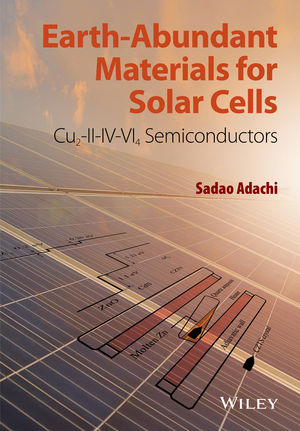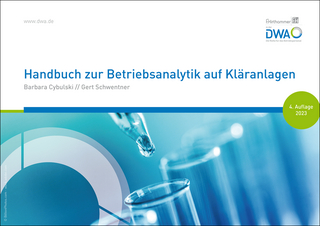
Earth-Abundant Materials for Solar Cells
John Wiley & Sons Inc (Verlag)
978-1-119-05277-7 (ISBN)
- Titel z.Zt. nicht lieferbar
- Versandkostenfrei innerhalb Deutschlands
- Auch auf Rechnung
- Verfügbarkeit in der Filiale vor Ort prüfen
- Artikel merken
Intended for scientists and engineers, in particular, in the fields of multinary semiconductor physics and a variety of photovoltaic and optoelectronic devices.
Professor Sadao Adachi, Division of Electronics and Informatics, Faculty of Science and Technology, Gunma University, Japan
Preface ix
Abbreviations and Acronyms xi
1 Introduction 1
1.1 Natural Abundance of Elements in the Earth’s Crust 1
1.1.1 Chemical Elements 1
1.1.2 Solar Cells and Earth-Abundant Materials 4
1.2 Solar Radiation Spectrum 5
1.3 Shockley–Queisser Efficiency Limit 6
1.4 Fundamental Properties of Photovoltaic Semiconductor Materials 8
1.5 Solar Cell Device Characteristics 11
1.6 Prediction of Physical Properties for Complex Material System 13
1.6.1 An Effective Medium Approximation 13
1.6.2 An Interpolation Scheme 15
References 19
2 Structural Properties 21
2.1 Grimm–Sommerfeld Rule 21
2.2 Crystal Structure and Phase Stability 22
2.2.1 Crystal Structure 22
2.2.2 Theoretical Phase Stability 24
2.3 Lattice Constant and Related Parameters 25
2.3.1 Bulk Material 25
2.3.2 Nanocrystalline Material 52
2.4 Structural Phase Transition 58
References 61
3 Thermal Properties 67
3.1 Phase Diagram 67
3.1.1 Cu2Zn–IV–VI4 Quaternary 67
3.1.2 Cu2Cd–IV–VI4 Quaternary 72
3.1.3 Cu2Hg–IV–VI4 Quaternary 75
3.1.4 Cu2–II–IV–VI4 Solid Solution 78
3.2 Melting Point 81
3.3 Specific Heat 86
3.4 Debye Temperature 88
3.5 Thermal Expansion Coefficient 89
3.6 Thermal Conductivity 92
3.6.1 Quaternary Material 92
3.6.2 Alloy Material 101
3.7 Thermal Diffusivity 107
References 107
4 Elastic, Mechanical, and Lattice Dynamic Properties 111
4.1 Elastic Constant 111
4.1.1 General Remark 111
4.1.2 Theoretical Value 113
4.1.3 Young’s Modulus, Poisson’s Ratio, and Similar 115
4.1.4 Sound Velocity 118
4.2 Microhardness 121
4.3 Lattice Dynamic Properties 124
4.3.1 Phonon Dispersion Relation 124
4.3.2 Raman Scattering: Tetragonal Lattice 126
4.3.3 Raman Scattering: Orthorhombic Lattice 133
4.3.4 Effect of Atomic Mass on Phonon Frequency 136
4.3.5 Raman Scattering: Solid Solution 137
4.3.6 Raman Scattering: Excitation Wavelength Dependence 143
4.3.7 Far-IR Spectroscopy 148
4.3.8 External Perturbation Effect 150
4.3.9 Nanocrystalline Material 156 References 166
5 Electronic Energy-Band Structure 173
5.1 General Remark 173
5.1.1 Energy-Band Structure 173
5.1.2 Γ-Point Energy-Band Scheme 180
5.1.3 Band-Gap Energy: External Perturbation and Doping Effects 183
5.1.4 Effective Mass: External Perturbation and Doping Effects 185
5.2 Lowest Indirect and Direct Band-Gap Energies 185
5.2.1 Quaternary Material 185
5.2.2 Solid Solution 201
5.3 Higher-Lying Band-Gap Energy 205
5.4 External Perturbation Effect on the Band-Gap Energy: Experimental Data 205
5.5 Effective Mass 211
5.5.1 Electron Effective Mass 211
5.5.2 Hole Effective Mass 217
5.6 Nanocrystalline Band-Gap Energy 218
5.6.1 Quaternary Material 218
5.6.2 Solid Solution 222
5.7 Heterojunction Band Offset 223
5.7.1 General Consideration 223
5.7.2 Theoretical Value 224
5.7.3 Experimental Value 225
5.8 Electron Affinity 233
5.9 Schottky Barrier Height 235
References 236
6 Optical Properties 245
6.1 General Remark 245
6.1.1 Dielectric Permittivity: Tensor Representation 245
6.1.2 Optical Dispersion Relation 246
6.1.3 Optical Spectrum: Classification into Several Regions 250
6.2 The Reststrahlen Region 253
6.2.1 Static and High-Frequency Dielectric Constants 253
6.2.2 Reststrahlen Spectrum 254
6.3 At or Near the Fundamental Absorption Edge 257
6.3.1 Exciton Parameter 257
6.3.2 Optical Absorption 261
6.3.3 Refractive Index 271
6.4 The Interband Transition Region 276
6.4.1 Model Dielectric Function 276
6.4.2 Optical Spectrum and MDF Analysis 279
6.4.3 Optical Absorption Spectrum 288
6.4.4 Optical Constant in the 0–10 000 eV Spectral Region 288
References 296
7 Carrier Transport Properties 301
7.1 Electron Transport Properties 301
7.2 Hole Hall Mobility 303
7.2.1 General Remark 303
7.2.2 Room-Temperature Value 304
7.2.3 Temperature Dependence 312
7.2.4 Effect of Stoichiometry, Alloying, and Foreign Atom Doping 319
7.3 Electrical Resistivity 327
7.3.1 Free-Hole Conduction 327
7.3.2 Hopping Conduction 332
7.3.3 Transport in Degenerate Band 334
7.3.4 Insulator-to-Metal Transition 335
7.4 Minority-Carrier Transport 339
7.4.1 Minority-Electron Mobility 339
7.4.2 Minority-Electron Lifetime and Diffusion Length 342
7.5 Effect of Grain Boundary 350
7.6 Proposal: Graded-Absorber Solar Cell Structure 352
7.7 Proposal: Controlling Transport Properties of Bulk Material by Heat Treatment 353
References 354
Appendix A Summary: Physical Properties of CZTS and CZTSe 363
Appendix B Summary: Physical Properties of c-CdS, w-CdS, and ZnO 369
References 376
Appendix C Optical Constants of Some Cu2–II–IV–VI4 Quaternary Semiconductors 379
References 414
Appendix D Optical Constants of c-CdS, w-CdS, and ZnO 415
References 441
Index 443
| Erscheint lt. Verlag | 2.12.2015 |
|---|---|
| Verlagsort | New York |
| Sprache | englisch |
| Maße | 175 x 252 mm |
| Gewicht | 839 g |
| Themenwelt | Naturwissenschaften ► Chemie |
| Technik ► Elektrotechnik / Energietechnik | |
| Technik ► Maschinenbau | |
| ISBN-10 | 1-119-05277-7 / 1119052777 |
| ISBN-13 | 978-1-119-05277-7 / 9781119052777 |
| Zustand | Neuware |
| Haben Sie eine Frage zum Produkt? |
aus dem Bereich


